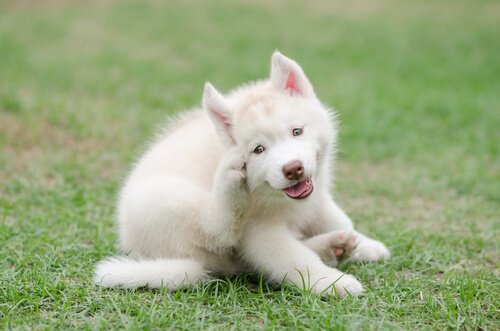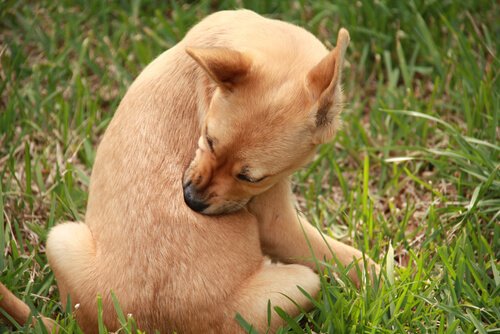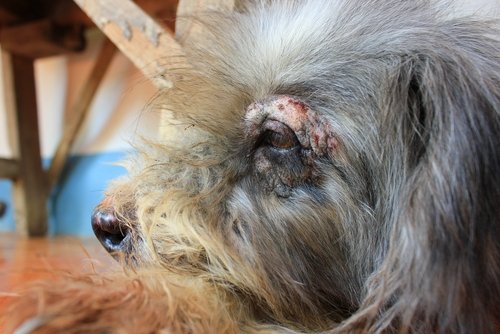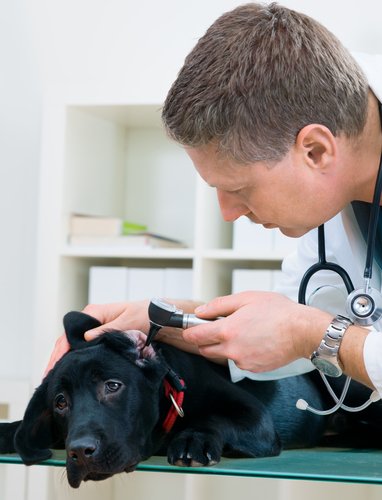All There is to Know About Dog Pruritis

You might not be familiar with the term, but dog pruritis is a common illness in dogs of all ages and breeds. It can also happen to house cats. In this article, we’re going to tell you about its main symptoms and what you can do to help your pet.
Dog Pruritis: what is it and how does it progress?
Veterinarians use the term “dog pruritis” when they refer to itchiness or the sensation of itchiness. This takes place when a dog has a strong, persistent urge to rub against things, scratch themselves, and bite and lick their skin and fur.

Pruritis is often isolated and it’s generally linked to the nervous system. But there are other diseases that can lead to it too. It mainly happens because of skin inflammation and allergies or ectoparasite infestations.
The prognosis for dog pruritis is usually positive as long as your dog is diagnosed at its early stages. If you don’t treat it properly it can lead to a complete or partial loss of fur. In serious cases, the wounds and sores from scratching themselves can cause bacterial infections.
Symptoms of dog pruritis
The main symptom of dog pruritis is intense itchiness. A dog might become obsessive and spend all day scratching and licking himself. A lot of dogs rub the itchy parts up against objects and furniture in the house or trees outside.
This can cause to things like:
- Skin redness and inflammation.
- Wounds and injuries from self-harm.
- Partial or complete loss of fur, known as alopecia.
The main causes of dog pruritis
The main cause of dog pruritis are ectoparasitic infections. Fleas, ticks, and mites can give them that intense itchiness and end up as skin irritation and inflammation.

Allergies are the second biggest cause of pruritis in domestic animals. They can come from all kinds of things like food, house products, dust, and natural allergens like mold or pollen. Some endoparasites like worms (ascaris) can also cause pruritis. It’s especially common in puppies under six months old.
The chemicals in some cleaning and cosmetic products are dangerous for animals. They can actually do more than just cause pruritis, they can even poison your dog.
Dog Pruritis: psychological factor
Dog pruritis can get worse when a dog starts to feel constant itchiness. Itchiness makes the dog scratch himself, which into turn makes the itchiness worse and causes the animal to starch himself to the point of self-harm.
This vicious cycle isn’t just physical. The feeling of itchiness is usually contagious and is linked to their nervous system. The sensation of itchiness on a dog’s skin sends messages to the brain through the nervous system. An animal’s immediate response is usually scratching in order to get quick relief and make this strange feeling go away.

That just leads to more irritation and more itchiness. As time goes on, the skin and nervous system irritation will only get worse. The psychological factor in pruritis is so big that it can actually make it contagious between humans and animals. There are a lot of cases where an owner gets imaginary pruritis from watching their dog scratch himself.
Treatment for dog pruritis
There’s not a single treatment for dog pruritis. Your vet might prescribe ointments, pills, or injections to reduce your dog’s urge to itch and hurt himself. They’ll normally recommend a change in diet and some tests to make sure there aren’t any underlying allergies. If your dog has a worm infestation, then he needs to have all the proper procedures done.
It’s extremely important not to medicate a dog with pruritis yourself. A lot of medications and home remedies can make their itchiness worse.

You should treat dog pruritis by following strict orders from the vet who diagnosed your pet.
Is it possible to prevent dog pruritis?
You can prevent pruritis by practicing good hygiene in your home, such as maintaining a clean, well-ventilated environment. Your dog also needs baths, brushing, petting, etc… A balanced diet and regular physical activity are also important because these habits improve your dog’s immune system. Pets with allergies also need to have a hypoallergenic diet.
Preventive medicine is vital to fighting parasites and allergies that can cause pruritis. Occasional trips to the vet also make it easier to get an early diagnosis of dog pruritis and other skin disorders.
All cited sources were thoroughly reviewed by our team to ensure their quality, reliability, currency, and validity. The bibliography of this article was considered reliable and of academic or scientific accuracy.
- Manzuc, P. (2008). Diagnóstico y Manejo a largo plazo del prurito. REDVET. Revista Electrónica de Veterinaria, 9(12).
- Bhagat, R., Sheikh, A. A., Wazir, V. S., Mishra, A., & Maibam, U. (2017). Food allergy in canines: A review. Journal of Entomology and Zoology Studies, 5(6), 1522-1525.
- Callan Sanchez, M. R. (2021). Endoparásitos zoonóticos en caninos domésticos (Canis lupus familiaris). (Trabajo de grado, Universidad Científica del sur).
